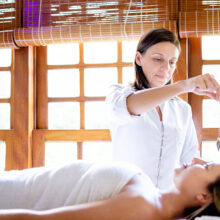Keep Yourself in the Dark, At Least at Bedtime
- Published: Monday, March 5th 2012
- in Mindset
by Lisa Mercurio, Bedtime Network
 I recently caught a savvy news clip on the new Boeing 787 and couldn’t help but think, “wow…this is so cool.”
I recently caught a savvy news clip on the new Boeing 787 and couldn’t help but think, “wow…this is so cool.”
In case you haven’t heard; the Boeing 787 is a new jet with the added pet name, “Dreamliner.” For once, it seems that there is more to brag about than additional legroom. Don’t get me wrong. They are bragging about legroom too but that wasn’t what really got my attention.
Amongst the Dreamliner’s many new innovations, there are two key features that control light during flight. For starters, new technology in digital window tinting allows the window-seated passenger along with the flick of a button to make the windows go dark. Gone are the sticky shades of yore. Note: if you are lucky enough to have the window seat, you’re in complete control of your flying universe, or so it seems.
The Dreamliner also allows the cabin crew to influence the color of the light in the cabin and, on the ceiling of the plane. What’s this crayola crayon palette really about? It means that they can gradually emulate sunrise on the ceiling of the jet, changing the color to a sunlit blue sky as the morning appears.
It’s great news for you, your body and your jet lag on those long, overnight flights which often signify the loss of a night’s sleep. We’re thinking that if the Dreamliner experience is as good as it seems, jet lag might just be a little bit easier to bear. Consider this: once the Dreamliner makes its way into everyone’s fleet, the next time you go to book that spa vacation, the flight itself might actually help you arrive more quickly into relaxation mode!
So, just how important is it to sleep in the dark whether on land or in the sky and what role does light play in our nocturnal life?
Just a little dip into the well-published world of sleep will reveal that we are all hard-wired to respond to light of all kinds. Why “hard wired?” Well, it goes back to our brain development and even to our ancestors who pragmatically understood the critical nature daylight played in their daily lives. Consider the rhythm of an average farmer’s day anywhere in the world before the era of electricity; up with the sun until day was done. There was no fieldwork that could be done in the dark. Later in the evening and depending on the time of year, the only available work light or reading light would be rather dim; emanating from candles, the family fireplace or eventually, gasoline lanterns. It wasn’t until Edison’s light bulb came into the picture that a typical “work day” could be extended. As for television….fugeddaboudit! Today’s backlit eReaders, portable handheld devices and other commonplace bright lights that interfere with our brain’s interpretation of daytime “up mode” versus nighttime, “sleep mode,” are only very recent sleep scene zappers.
Our ancestors were creatures of necessity; rising with the sun and sleeping with the moon; responding to the gifts of light brought forth by Mother Nature. No one checked an iPhone or Blackberry in the middle of the night.
The disruption to the amount of light we receive or absorb during the day and/or a change of the hour that we perceive “darkness” all have an effect on our sleep cycle (circadian rhythms) and, our moods. Melatonin, often referred to as the “hormone of sleep,” is secreted by the brain and critical to sleep. When it’s dark, our melatonin production goes up. If you are over-stimulated by light, (which typically happens during jet-lag) chances are, your brain will not get the necessary melatonin release signaling bedtime’s approach.
Similarly, if errant light hits you during the course of a typical night’s sleep, chances are good that it might wake you too. At Bedtime Network, we often hear people say, “I have to leave the TV on to fall asleep, but then, I wake up in the middle of the night when I hear it.” Yes, noise is a factor, but this often has to do with the fact that the light from the television has changed. Perhaps it’s a change of program or a simple, brightly lit infomercial that dances across your closed eyelids and reaches your brain. Suddenly, the lulling effect is gone and you are awake and not blissfully (!) at 3 am.
Fortunately, there are a lot of easy steps to take to deliver the kind of ambient light desirable for a good night’s sleep.
Bedtime Network’s 5 easy tips for better night/light control:
1 – Avoid television, computers and backlit handheld devices at least 90 minutes before bedtime. If you cannot bear to miss your favorite program, tape it and watch it another time.
2 – Avoid bright lights before bedtime. Soft lights (low-wattage bulbs) are more conducive to sleep.
3 – Make sure your room is dark, dark, dark. If you live in a big city where there is plenty of street activity, consider double-backed shades.
4 – Eye masks: there are a million of them on the market. If you feel it makes you look like Zorro, find one that is light, silky; whisper thin.
5 – Nightlights: Not just for kids, we know. Try for something small and discrete and very, very dim, especially if you’re in a strange hotel room. Obviously, safety is the first consideration.
While I never advocate staying “in the dark” for most things in life (knowledge is power after all), in the case of sleep, it’s a definite advantage. Now, if the airlines can just figure out how to give everyone power and control over their own window we’ll really have it made. And then again, there is always a sleep mask.
Sweet dreams!


